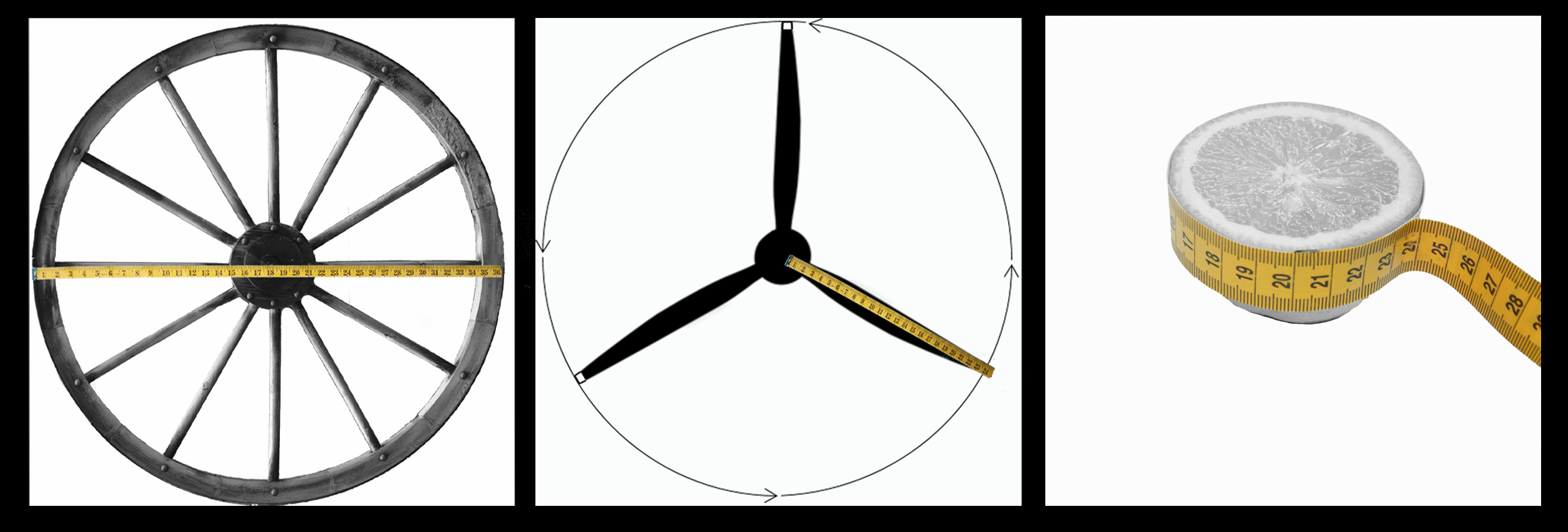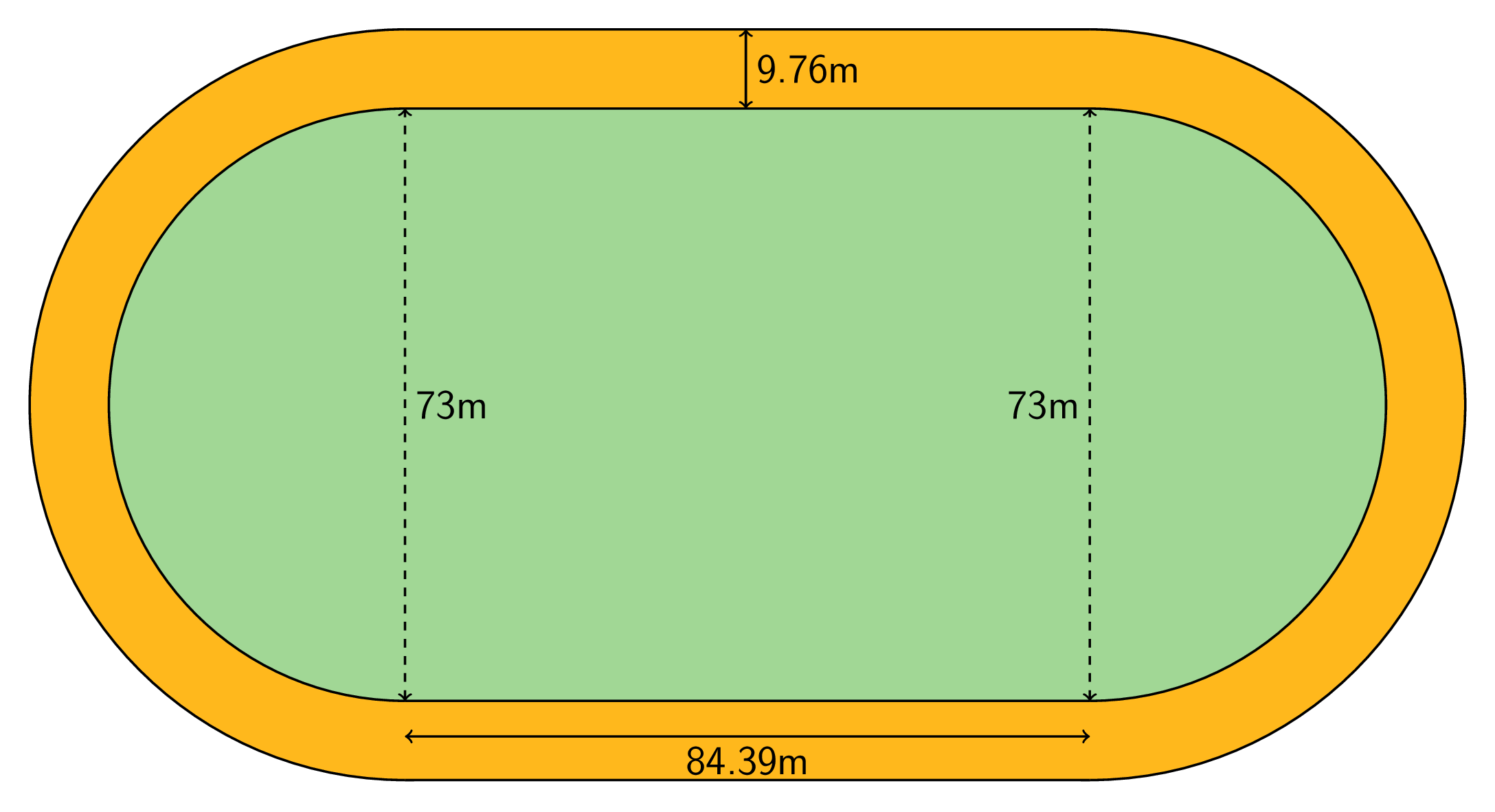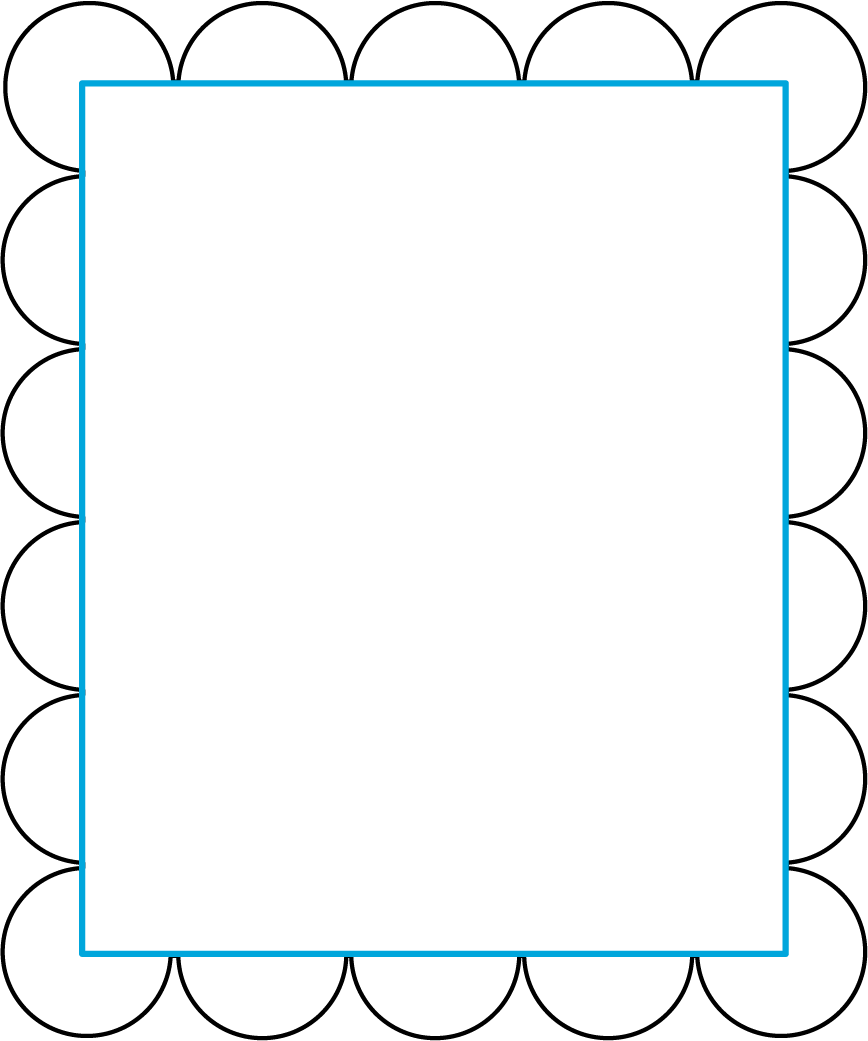Lesson 4
Applying Circumference
4.1: What Do We Know? What Can We Estimate? (5 minutes)
Warm-up
The purpose of this warm-up is for students to reason about the various measurements of a circle. In each of the pictures, students are given a piece of information about the circle and asked to reason about the other measurements of the circle. Some of these measurements can be found based on the given information while others, without a calculator, would require an estimate.
Launch
Arrange students in groups of 2. Give students 1 minute of quiet think time followed by 2 minutes to discuss their estimates with a partner.
Student Facing
Here are some pictures of circular objects, with measurement tools shown. The measurement tool on each picture reads as follows:
- Wagon wheel: 3 feet
- Plane propeller: 24 inches
- Sliced Orange: 20 centimeters

-
For each picture, which measurement is shown?
-
Based on this information, what measurement(s) could you estimate for each picture?
Student Response
For access, consult one of our IM Certified Partners.
Activity Synthesis
For each picture, ask selected students to share the measurements shown in the pictures. Ask students to explain the strategies or calculations they would use for computing or estimating other measurements (for example, the radius and circumference of the wheel). Record and display student responses on the actual pictures. Refer to MLR 2 (Collect and Display) to highlight student responses and language about what they know and what they estimated.
4.2: Using $\pi$ (10 minutes)
Activity
In the previous lesson, students identified the constant of proportionality relating the circumference and diameter of a circle. The purpose of this activity is for students to calculate measurements of a circle using different approximations of \(\pi\). Students are given either the radius, diameter, or circumference of a circle and use calculators to compute the other two measurements. Different students use different approximations of \(\pi\): \(\frac{22}{7},\) 3.14, and 3.1415927. The last approximation for \(\pi\) is the precision that many calculators show.
The different approximations for \(\pi\) lead to different estimates for the missing measurements, and they should be encouraged to think about which approximation is the most useful in these cases.
Launch
Divide students into 3 groups. Assign each group a different approximation for \(\pi\) to use in their calculations: 3.1415927, 3.14, and \(\frac{22}{7}\). Give students 4–5 minutes of quiet work time followed by whole-class discussion.
If using the digital activity, students can work in small groups to complete the task. The applet demonstrates the relationship between rotation and circumference.
Supports accessibility for: Organization; Attention
Student Facing
In the previous activity, we looked at pictures of circular objects. One measurement for each object is listed in the table.
Your teacher will assign an approximation for \(\pi\) for you to use in this activity.
- Complete the table.
object radius diameter circumference wagon wheel 3 ft airplane propeller 24 in orange slice 20 cm - A bug was sitting on the tip of the propeller blade when the propeller started to rotate. The bug held on for 5 rotations before flying away. How far did the bug travel before it flew off?
- If you choose to, you can change the settings in the applet and enter your calculation in the box at the bottom to check your work.
- Just for fun, use the slider marked “turn” to watch the bug’s motion.
Student Response
For access, consult one of our IM Certified Partners.
Launch
Divide students into 3 groups. Assign each group a different approximation for \(\pi\) to use in their calculations: 3.1415927, 3.14, and \(\frac{22}{7}\). Give students 4–5 minutes of quiet work time followed by whole-class discussion.
If using the digital activity, students can work in small groups to complete the task. The applet demonstrates the relationship between rotation and circumference.
Supports accessibility for: Organization; Attention
Student Facing
In the previous activity, we looked at pictures of circular objects. One measurement for each object is listed in the table.
Your teacher will assign you an approximation of \(\pi\) to use for this activity.
- Complete the table.
object radius diameter circumference wagon wheel 3 ft airplane propeller 24 in orange slice 20 cm - A bug was sitting on the tip of the propeller blade when the propeller started to rotate. The bug held on for 5 rotations before flying away. How far did the bug travel before it flew off?
Student Response
For access, consult one of our IM Certified Partners.
Activity Synthesis
Compare the measurements that students calculated using the different approximations of \(\pi.\) Point out that while the approximation for \(\pi\) influences the values of the radius and diameter, it does not affect the relationship \(d=2\boldcdot r.\) Use the circumference of the wagon wheel to point out that all three results (9.4285714 ft, 9.42 ft, and 9.4247781 ft) agree in the first three digits, i.e., to within a hundredth of a foot. Explain that even when using 3.1415927, the measurements are still approximations.
Discuss whether 9.4247781 ft for the circumference of a wagon wheel or 3.183098815 cm for the radius of an orange slice is a reasonable number of decimal places to report the measurement. Could these objects actually be measured that precisely? Explain that people use different approximations for \(\pi\) depending on the situation and the precision of the measurement. For situations like these where the measurements themselves do not have too much accuracy either 3.14 or \(\frac{22}{7}\) is probably the most appropriate value of \(\pi\) to use. Using a more accurate value for \(\pi\) is always acceptable, but the final answer should not be reported with more accuracy than the measurements.
When working with circles, sometimes it is more natural to work with the diameter and sometimes with the radius. But we can always go quickly from one to the other, if needed. Emphasize the progression in solving the propeller problem: use the radius to get the diameter, then the diameter to get the circumference. It is not necessary for students to learn the rule \(C = 2 \pi r\), but this would be the place to do so if desired.
Design Principle(s): Support sense-making; Cultivate conversation
4.3: Around the Running Track (15 minutes)
Optional activity
In this activity, students compute the length of a figure that is composed of half-circles and straight line segments. For the first question, they are given the length of the line segments and the diameter of the circle. For the second question, students have to compute the diameter of the circle.
As students work, monitor for students who decomposed the figure in different ways and used different approximations of \(\pi\). The discussion focuses on whether the differences lead to meaningful differences in the estimate for the distance around the track.
Launch
If desired, introduce the context of a running track. Allow students to choose what approximation to use for \(\pi\). Quiet work time followed by partner discussion.
Supports accessibility for: Language; Organization
Design Principle(s): Maximize meta-awareness; Support sense-making
Student Facing
The field inside a running track is made up of a rectangle that is 84.39 m long and 73 m wide, together with a half-circle at each end.

- What is the distance around the inside of the track? Explain or show your reasoning.
- The track is 9.76 m wide all the way around. What is the distance around the outside of the track? Explain or show your reasoning.
Student Response
For access, consult one of our IM Certified Partners.
Student Facing
Are you ready for more?
This size running track is usually called a 400-meter track. However, if a person ran as close to the “inside” as possible on the track, they would run less than 400 meters in one lap. How far away from the inside border would someone have to run to make one lap equal exactly 400 meters?
Student Response
For access, consult one of our IM Certified Partners.
Anticipated Misconceptions
If students have trouble seeing the circle and rectangle that compose the figure, suggest that they draw additional lines to decompose the figure.
Students might apply the formula for the circumference of a circle to find the circumference of the oval-shaped field and track. If this happens, remind students that the track is not in the shape of a circle. Ask if they see a way to form a circle and a rectangle within the space.
Students who are familiar with the fact that this size track is referred to as a 400-meter track may be confused when their answer does not equal 400 meters. Explain that a runner does not run right on the edge of the track and possibly direct the student to look at the extension.
Activity Synthesis
Most of the discussion will occur in small groups. However, the whole class can debrief on the following questions:
- “In what ways did you decompose the figure into different shapes?”
- “Why did you choose a particular approximation for \(\pi\), and what was the resulting answer?”
- “How are different students’ answers related, and are they all reasonable lengths for this situation?”
Students who use more digits for their approximation of \(\pi\) may come up with a slightly different answer, such as 398.1. In general, when making calculations, if only an estimate is desired, then using 3.14 for \(\pi\) is usually good enough. In a situation like this, where the given measurements are quite precise, it can be worth trying more digits in the expansion of \(\pi\), but it turns out not to make much difference in this case.
4.4: Measuring a Picture Frame (10 minutes)
Activity
The purpose of this activity is to calculate the length of a complex shape made out of parts of circles. Students are given a drawing of a picture frame that is made up of half-circles and three-quarter circles and are asked to find the total length required to make the frame out of wire. Next, students are asked what the radius would be of a circle with a circumference equal to the picture frame’s perimeter. This activity marks the first time that the term perimeter is used in the context of circumference.
As students work, monitor and select students who approach the problem differently to share their solution methods in the discussion. There are many different methods to calculate the perimeter of the wire that show different ways of thinking about the circles and combining them (MP7): 10 full circles, 7 full circles from the half-circles and 3 full circles from the \(\frac{3}{4}\) circles, 18 separate parts of circles.
Launch
Display the image from the task statement and ask students to share what they notice and what they wonder. Confirm that the shapes are half-circles and \(\frac{3}{4}\) of a circle in each corner. Also, tell them that all of these circles are the same size.
Give students quiet work time followed by whole-class discussion.
Supports accessibility for: Organization; Attention
Design Principle(s): Support sense-making; Maximize meta-awareness
Student Facing
Kiran bent some wire around a rectangle to make a picture frame. The rectangle is 8 inches by 10 inches.

- Find the perimeter of the wire picture frame. Explain or show your reasoning.
- If the wire picture frame were stretched out to make one complete circle, what would its radius be?
Student Response
For access, consult one of our IM Certified Partners.
Anticipated Misconceptions
Some students may not have realized the connection between circumference and perimeter and will need to be prompted to use the circumference of the circular pieces to find the perimeter of the wire frame.
Students might try to include the perimeter of the rectangle when calculating the perimeter of the wire frame. Explain that we are only looking for the length of all the circular pieces.
Once they have figured out the size of each half-circle’s diameter, it might be challenging for some students to imagine the frame being stretched to form one complete circle. Suggest that the entire length of the frame becomes the circumference of the complete circle. It might be helpful to have some string and an index card available for students to explore the idea of bending and stretching the frame.
Activity Synthesis
Ask the students how they used the dimensions of the picture frame to find the radii of the circles. The long side, for example, is made up of 4 diameters and 2 radii of circles. That is the same as 10 radii so if that side measures 10 inches, then the radius of the circle is 1 inch.
Ask select students to share different ways they decomposed the wire frame into parts. Possible methods include:
- 14 half-circles + 4 three-quarter circles
- 7 full circles + 4 three-quarter circles
- 7 full circles + 3 full circles
- 10 full circles
Ask students to discuss how they used the circumference of the circle in their work. If it does not arise in discussing the second question, make explicit the idea that knowing the circumference of the circle allows you to work backwards to find the circle’s radius.
Lesson Synthesis
Lesson Synthesis
The main ideas are:
- The proportional relationship between diameter and circumference of a circle can be applied in more complex situations that require multi-step solutions.
- Because the diameter is twice the radius, we can write the relationship between the circumference of a circle and its radius like this: \(C = 2\pi r\).
Discussion questions:
- What are some approximations of \(\pi\)?
- If I know the radius of a circle, how do I find its diameter and circumference?
- What if I know the circumference? How do I find diameter or radius?
4.5: Cool-down - Circumferences of Two Circles (5 minutes)
Cool-Down
For access, consult one of our IM Certified Partners.
Student Lesson Summary
Student Facing
The circumference of a circle, \(C\), is \(\pi\) times the diameter, \(d\). The diameter is twice the radius, \(r\). So if we know any one of these measurements for a particular circle, we can find the others. We can write the relationships between these different measures using equations:
\(\displaystyle d = 2r\) \(\displaystyle C = \pi d\) \(\displaystyle C = 2\pi r\)
If the diameter of a car tire is 60 cm, that means the radius is 30 cm and the circumference is \(60 \boldcdot \pi\) or about 188 cm.
If the radius of a clock is 5 in, that means the diameter is 10 in, and the circumference is \(10 \boldcdot \pi\) or about 31 in.
If a ring has a circumference of 44 mm, that means the diameter is \(44 \div \pi\), which is about 14 mm, and the radius is about 7 mm.